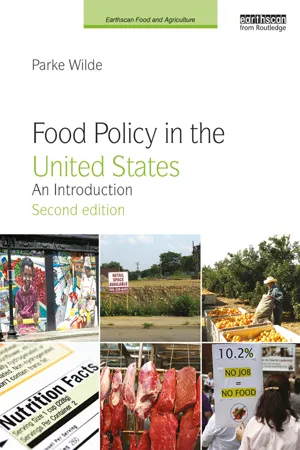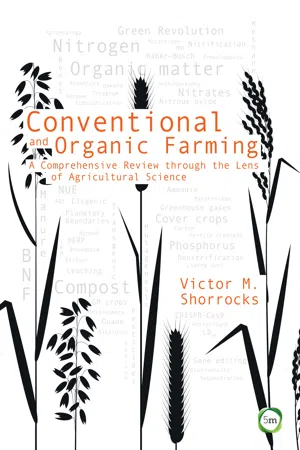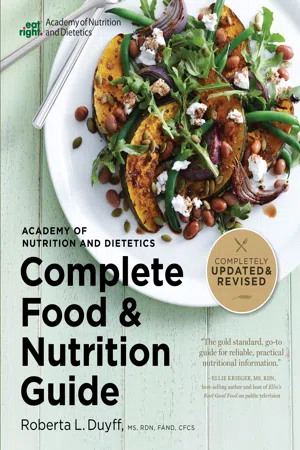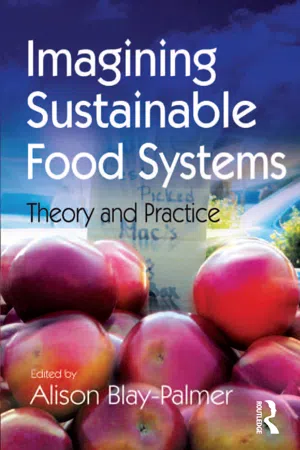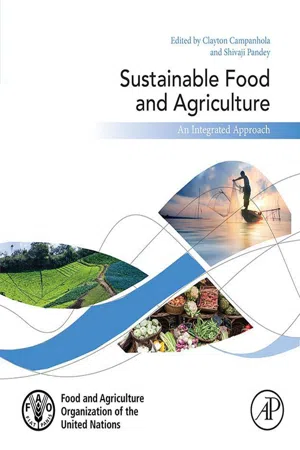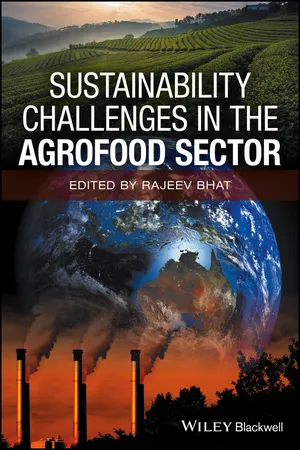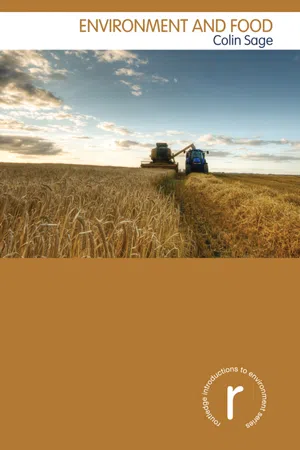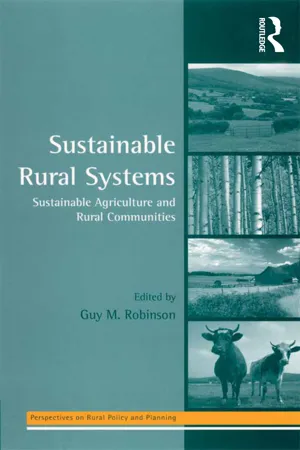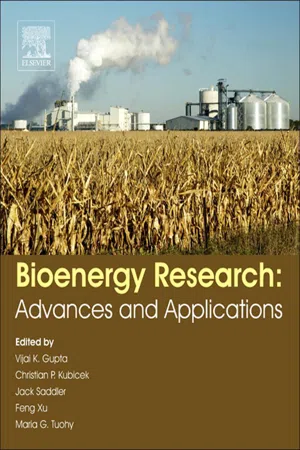Geography
Sustainable Production of Food
Sustainable production of food refers to the method of growing, harvesting, and distributing food in a way that meets current needs without compromising the ability of future generations to meet their own needs. It involves practices that minimize environmental impact, conserve natural resources, and support the well-being of farmers and local communities. This approach aims to ensure food security and reduce negative effects on the planet.
Written by Perlego with AI-assistance
Related key terms
Related key terms
1 of 4
Related key terms
1 of 3
12 Key excerpts on "Sustainable Production of Food"
- eBook - ePub
Food Policy in the United States
An Introduction
- Parke Wilde(Author)
- 2018(Publication Date)
- Routledge(Publisher)
3 Food Production and the Environment3.1 Introduction
Food production connects us to each other and to the natural environment. In the 2006 bestseller The Omnivore’s Dilemma, Michael Pollan writes, “Though much has been done to obscure this simple fact, how and what we eat determines to a great extent the use we make of the world—and what is to become of it” (Pollan, 2006).In discussions of agriculture and the environment, a commonly stated goal is agricultural sustainability. In its original literal meaning, sustainability requires maintaining the resource base on which agriculture depends. More broadly, agricultural sustainability has become a shorthand term for a bundle of environmental, economic and social objectives (National Research Council, 2010; FAO, 2014): satisfying human food, feed and fiber needs and contributing to biofuel needs; enhancing environmental quality and the resource base; sustaining the economic viability of agriculture; and improving the quality of life for farmers, farmworkers and society as a whole. In this broader sense, agricultural sustainability involves environmental objectives addressed in this chapter and also other public interest objectives throughout this book.This chapter:- introduces economic principles for thinking about environmental externalities (Section 3.2 );
- summarizes five environmental dilemmas in U.S. food production (Section 3.3 );
- gives an overview of the global food situation, including trends in food needs and environmental constraints on global food production (Section 3.4 );
- reviews current policies to address environmental challenges in the U.S. food system (Section 3.5 ); and
- discusses the contemporary explosion of interest in organic and locally grown food (Section 3.6 ).
3.2 The Economics of Environmental Externalities
At their best, markets create a strong incentive for environmentally sound decisions about resource use and the environment. At their worst, private-sector market incentives can generate environmental problems, such as pollution and over-use of valuable resources. This section explores the potential successes and failures of market incentives using a series of examples. In each example, food producers face a difficult decision about how much to produce, with potential environmental consequences. - eBook - ePub
Global Food Futures
Feeding the World in 2050
- Brian Gardner(Author)
- 2013(Publication Date)
- Bloomsbury Academic(Publisher)
2What is meant by sustainability in an agricultural context? The most concise modern definition of sustainability is that evolved by the Brundlandt Commission in 1987: “development that meets the needs of the present without compromising the ability of future generations to meet their own needs.”3 This definition has been subsequently extended beyond the obvious environmental condition to include social and economic conditions as well. It is obvious that ensuring that agriculture sustains the productive capacity of the soil of the planet is essential to the survival of the human race and most other fauna and flora.What is also obvious is that because food is essential to life, human communities will seek the easiest way of maximizing the food supply; in terms of the long-run productive capacity of the soil, this may not be the optimum. Without doubt, feeding more than 7 billion human bodies currently involves a large part of Earth’s resources. It is estimated that about 38 percent of Earth’s land surface and about 20 percent of its net primary production resources are involved in the production of food.4 Also to be taken into account is the impact of the production of the resources needed to produce agricultural inputs: irrigation water, fertilizers and pesticides, machinery, and energy. The resource costs of delivery to consumers—packaging, transport and retailing facilities—also have to be taken into account.In determining the level of food production, farmers are responsible for influencing the state of a large part of the global environment. Agriculture is therefore in a position to cause the loss of natural ecosystems and add globally significant and environmentally detrimental amounts of nitrogen and phosphorus to terrestrial ecosystems. It has been estimated that the quantities involved could triple if past practices are used to achieve another doubling in food production.5 - eBook - ePub
- Victor M. Shorrocks(Author)
- 2017(Publication Date)
- 5m Books(Publisher)
The 2016 Global Food Policy Report, the flagship publication of the International Food Policy Research Institute (IFPRI, 2016), points out that today’s global food system has major weaknesses with nearly 800 million people left hungry and one-third of the human race malnourished; more than half of some crops never make it to the table and the environment is being damaged by current farming practices. The IFPRI (2016) wishes to see a new global food system developed that is efficient, inclusive, climate-smart, sustainable, nutrition and health-driven. It is thought that climate change will have negative impacts on crops, especially on the millions of dry land smallholders in Africa. The perceived solution is seen in the form of crops better able to deal with drought but there is no commitment to GM crops.Sustainable agriculture
What is a sustainable farming system? One definition given by Gregorich et al. (2001) is that it is a system that includes steps to ensure natural resource conservation, economic productivity and social acceptability. A more general definition of a sustainable development was that given by the Brundtland Commission in 1987 as one which meets the needs of current generations without compromising the ability of future generations to meet their own needs (UNECE, 1987).The consumption by man of nutrients that are not replaced means that it will not be possible to sustain food production indefinitely once all cultivatable land is farmed. It could be that organic farming would remain sustainable as a system longer than conventional farming insofar as the lower yields would reduce the rate of loss of nutrients. At the same time, organic farming would only have the ability to sustain a relatively small global population.An acceptable global sustainability target is here considered to be the ability to feed a population of around 11 billion with a lifestyle and diet comparable to the current Western standards but possibly with reduced consumption of livestock products. There would seem to be little merit in contemplating a world with completely unrealistic diets, for example with only minimal dependence on animal products and seed legumes being the main source of protein for humans.Current agricultural practices are thought to be able to produce more than sufficient food for the current global population of c. 7.2 billion. The dietary inadequacies in underdeveloped countries are said to be largely due to economic and political factors that prevent fair distribution of food and the non-adoption of agricultural techniques that have been successful in the Western world. There is also considerable waste of food at all steps in the food chain from field to plate. Approximately one third of the food produced in the world for human consumption every year is lost or wasted, either by producers and during marketing or by the consumer in the home (FAO, 2016). Roughly the same total quantities of food per capita are wasted in developed and developing countries. Consumers in developed countries are the main culprits, wasting far more food than those in developing countries. In developing countries most wastage occurs in post-harvest handling and processing. Fruits and vegetables have the highest wastage rates of any food. The amount of food lost or wasted every year is equivalent to more than half of the world’s annual cereals crops. In the UK it was reported in 2014 that of the 15 million t of food wasted each year, 9 billion t could have been eaten (UK Select Committee meeting on food security). - Roberta Duyff(Author)
- 2017(Publication Date)
- Harvest(Publisher)
right foods for as many people as possible, protecting against food- and water-related health issues, and managing environmental resources. A tall order.Sustainability is essential to meet the growing demand for food and the capacity to maintain resources, without compromising future generations’ ability to do the same. The term “sustainable” is often misunderstood, however. In the context of food it doesn’t mean “local” or “organic.” Instead “sustainable” refers to a food system that can maintain itself in healthy and responsible ways. And it’s about connections with the economy, the environment, and society as a whole—all important to ensure adequate food for future generations.Source: Academy of Nutrition and Dietetics.Sustainability in farming and ranching is important since they have so much potential impact on the environment. Sustainable agricultural production relies on (1) fertile soil with reduced soil erosion, (2) plenty of fresh water that’s not impaired with polluters, and (3) available energy that limits greenhouse gas emissions. Issues, such as water scarcity for irrigation, a loss of soil productivity, air and water pollution related to farming practices, potential loss of biodiversity, and pesticide and herbicide resistance, are high priority. The whole system—from farm to plate—must be mindful of:- Managing waste
- Conserving, protecting, and regenerating natural resources such as soil, water, and fossil fuels as well as landscapes
- Protecting the environment from practices that may harm public health
- Preserving the diversity of plants, animals, and soil nutrients
- Using ecologically sound practices when it comes to farming and food production and distribution
- Maintaining and working to improve the economic health and vitality of communities
- Distributing raw ingredients to food companies, processing and packaging them, and then getting the food to wholesalers, retail outlets, restaurants, and ultimately to your table
Tools of science and agricultural technology equip farmers and ranchers to manage natural resources. Food producers in the United States—helped by the US Department of Agriculture (USDA)—have reduced soil erosion by more than 40 percent in the past three decades. They’ve also encouraged wetland restoration and the production of renewable energy such as from wind and biofuels. Drip irrigation is controlling the amounts of water dispersed so that less is wasted. And with satellite guidance, farmers can plant and use pesticides and fertilizers more precisely. They also can match seeds and production practices to the soil type and climate. Yet, there is still so much to do.- eBook - ePub
Imagining Sustainable Food Systems
Theory and Practice
- Alison Blay-Palmer(Author)
- 2016(Publication Date)
- Routledge(Publisher)
Food systems offer a lens to dissect these new relationships. As a fundamental human need and right (UN 1948) food offers a prism to consider and address sustainability challenges as it translates complicated issues into meaningful ideas, policy and actions. First, as we all eat, food is something everyone can relate to and understand. Second, food unites all dimensions of sustainability – environmental, economic, and socio-cultural spaces – and allows us to explore the interconnected, fluid relationships simultaneously. We can grasp the importance of environmental stewardship when we consider the need for healthy food, soil and biodiversity, all of which can be achieved through ecologically sensitive, enabled farmers. It becomes clear through local food consumption that we can diminish our impact on the environment by reducing food miles. And, it is now more widely understood that buying food from nearby farmers, food processors and retailers keeps money in local economies. Further, social justice issues are more sharply defined as we compare access to healthy, culturally appropriate food across different communities and simultaneously consider the need to support fairly-traded food from developing countries (Morgan 2008). As Kloppenberg and his colleagues explain, to bring about a societal transformation, ‘We start with food. Given the centrality of food in our lives and its capacity to connect us materially and spiritually to each other and to the earth, we believe that it is a good place to start’ (1996: 40).This book offers a window into how we do/can create and theorize sustainable communities through food systems. On the practical side we explore the role of planning, social inclusion, public procurement and innovation as lenses for understanding sustainable food systems. Theoretically the book merges rural sociology, geographies of food, the greening of the economy and the politics of care as we expand our discussions about the connections and pull of/on food in society, the environment and the economy. The book adds to international scholarship through the identification of best practices for sustainable food systems. Importantly, the volume provides a grounded interdisciplinary approach to how we think about and create sustainable, flexible food systems by merging thinking from multiple disciplines with insights from practitioners. - eBook - ePub
Sustainable Food and Agriculture
An Integrated Approach
- Clayton Campanhola, Shivaji Pandey(Authors)
- 2018(Publication Date)
- Academic Press(Publisher)
Following the definition in the Brundtland Report (World Commission on Environment and Development, 1987) and adopted by the 2030 Agenda for Sustainable Development (UN, 2015), sustainability is understood as a problem of both intra- and intergenerational equity. The Brundtland Commission described sustainable development as: “…. development that meets the needs of the present without compromising the ability of future generations to meet their own needs.” This entails simultaneously addressing both the needs of those who are poor and hungry today and those of future generations, otherwise described as “cooperating with the future” (Hauser et al., 2014). Concerns about the sustainability of food and agriculture as it currently exists are outlined in a recent FAO report— Building a Common Vision for Sustainable Food and Agriculture (FAO, 2014) —which describes sustainability in terms of the following five principles: • Improving efficiency in the use of resources is crucial to sustainable agriculture. • Sustainability requires direct action to conserve, protect, and enhance natural resources. • Agriculture that fails to protect and improve rural livelihoods, equity, and social well-being is unsustainable. • Enhanced resilience of people, communities, and ecosystems is key to sustainable agriculture. • Sustainable food and agriculture (SFA) requires responsible and effective governance mechanisms. For the purpose of this section, we frame sustainability in terms of the conflict between escalating human needs and demands on one side, and increasing resource scarcity and environmental degradation on the other. While this conflict is not new, the decline of environmental conditions and of productive capacity has sharply accelerated recently, notably in the form of climate change. The opposition between the Earth’s natural system and the human system is mediated by food and agriculture, engaged in a coevolution with both sides - eBook - ePub
- Rajeev Bhat, Rajeev Bhat(Authors)
- 2017(Publication Date)
- Wiley(Publisher)
Agriculture is linked very closely to the environment; any actions that farmers take will inevitably affect the environment and at the same time are affected by climate change. There is a serious need for improvement in the production (supply side) of agricultural products so that it can sustain a growing world population. A large percentage of that population will also migrate to an urban setting as urbanization continues apace. Better access to available agrofood products is an equally important subject (demand side). With the trend of urbanization and population migration to the city continuing, the issue of access to products needs to be considered.Each of us has a role and responsibility to promote sustainable development in agrofood businesses. We can support the growth of sustainable development by supporting government policies that set clear and simple guidelines for transparency of information and that support products which follow the standards and are environmentally friendly. Research and development in the agrofood industry is also very important and should be supported both by governments and by private funding. Innovations such as biological catalysts and renewable energy can herald a new age of sustainable production of agricultural and food products. Finally, each of us has a responsibility to help reduce food waste. Food waste constitutes a large and growing problem. We need to focus on making the public aware of the problem and providing it with possible solutions. Policies with the right incentives such as an increase in rubbish or food waste collection cost can help alleviate the problem.We need to understand that foods are limited resources and should not be spoiled or wasted. The production of foods has sustained population increases in the preceding centuries because of innovation, expansion and industrialization in the agrofood industry. It is important to understand that we, as a society, have been using up available arable land and resources to sustain this population growth. Therefore, we need to start – today – to innovate and to adopt sustainable development concepts in the agricultural and food businesses so that the next generation can live in a world that is as good as it is today. - eBook - ePub
- Colin Sage(Author)
- 2011(Publication Date)
- Routledge(Publisher)
et al. (2010) observe, sustainability must refer to explicit qualities of human wellbeing, economic justice and ecological integrity: it must always embody environment, economy and society. Efforts to bracket off “sustainable” solely in relation to the economy (“sustainable growth”) or the environment usually reflect its capture by powerful interests for their own ends, and should be resisted. In this regard, Maxey’s observations are entirely pertinent when he refers to the growing number of claims for “sustainable” practices in relation to food provisioning, when there are so few for those that are “unsustainable”. It may be the case that encouraging a more explicit rendering of the values, practices, scale and impacts of truly sustainable food production will expose the shortcomings, concealment, profit-seeking motives and unsustainable dynamics of the mainstream agri-food system (Maxey 2007).Further ReadingLeach, M., Scoones, I., Stirling, A. (2010) Dynamic Sustainabilities: Technology, Environment, Social Justice. London: Earthscan.This book builds on a body of work conducted at the University of Sussex over the past two decades or more, outlining the tools that are needed for thinking about a diversity of pathways to sustainability. It is global in scope and explores other sectors and issues besides food.Pretty, J. (ed.) (2005) The Earthscan Reader in Sustainable Agriculture. London: Earthscan.Twenty-seven chapters comprising a variety of different perspectives: North and South, social and agroecological.Lang, T., Barling, D., Caraher, M. (2009) Food Policy: Integrating Health, Environment and Society. Oxford: Oxford University Press.The authors outline an integrative approach to food policy, which they call “ecological public health”. Although dealing very largely with the UK, it offers a thoroughly comprehensive analysis of why sustainability should underpin food planning. - eBook - ePub
Hamburgers in Paradise
The Stories behind the Food We Eat
- Louise O. Fresco(Author)
- 2015(Publication Date)
- Princeton University Press(Publisher)
The goal is therefore shifting from making a profit to contributing to a stable society where buying power increases and can continue to increase because the ecological foundations are not being undermined. Almost all companies in the food sector in rich countries have launched ambitious plans for socially responsible business practices. There are now international agreements about how to monitor progress. The subject is on the agenda of almost every meeting of senior managers. Ambitions extend from sustainable cultivation (including the training of farmers and the establishment of cooperatives) to environmentally friendly processing, a reduction in packaging, low-energy transportation, information provision for clients, and general involvement in social projects. One side effect turns out to be that staff feel motivated by plans of this kind and like to work for a company that’s leading the way. Because of all these activities, and because governments have become stuck in fragmented policy, Western companies are playing a large, sometimes decisive, role in the move toward sustainable food production.Correction of the failures of the free market, step by step, is essential but not sufficient to foster sustainability. The time horizon of capitalism is almost always limited to the short to medium term, whereas to find sustainable solutions we need to be conscious of a more distant future. Changes in the fields of energy and technology demand long-term stability to ensure that investments are not merely responses to short-term fluctuations and subsidies. Currently we set to work on wind or solar energy only if the oil price is high enough, and when it falls again we’re left wondering whether we’ve invested enough to make those alternatives profitable.Ultimately, sustainable food production is the responsibility of the state. This does not necessarily mean that state intervention is required. The state must create the conditions for sustainable food supply chains to work, through a combination of legal, fiscal, and policy measures. Markets and companies must operate in this framework, and only where markets fail should the state intervene, perhaps when an unforeseen disaster occurs, or when goals other than the production of consumer goods are regarded as important, as with the protection of the landscape. - eBook - ePub
- Peter J. Gregory, Stephen Nortcliff, Peter J. Gregory, Stephen Nortcliff(Authors)
- 2012(Publication Date)
- Wiley-Blackwell(Publisher)
13 The new challenge – sustainable production in a changing environmentPeter J. Gregory1, 2 and Stephen Nortcliff31 Centre for Food Security, School of Agriculture, Policy and Development, University of Reading, Reading, UK 2 East Malling Research, Reading, UK 3 Department of Geography and Environmental Science, Soil Research Centre, University of Reading, Reading, UK13.1 Introduction
The last 60 years have seen a large increase in the world’s population from about 2.2 billion in 1950 to about 7 billion in 2011. Accompanying this increase has been a substantial increase in food production and use of resources such as energy, water and land not only to produce food but also to satisfy changed, generally more affluent and resource-demanding, lifestyles. In the last 50 years, production of cereal grains such as maize, rice, wheat and barley has almost tripled, while production of root crops such as potato and cassava has increased by around 40% and that of the coarse grains millet and sorghum by about 20%. Simultaneously, diets have changed to consume more meat so that numbers of chickens have increased 4.5-fold, pigs have increased 2-fold and cattle and sheep have increased by about 30% (Godfray et al., 2010).Much of this increased production has come about by intensifying production systems and increasing yields (see Section 13.2.1 for more details), but it has often been achieved at some cost to other aspects of the environment. For example, excessive nutrient inputs, especially of nitrogen and phosphorus, have resulted in coastal eutrophication and reduced the quality of water in reservoirs used for drinking water (Vitousek et al., 2009). Similarly, cultivating soils for crop production has often increased the frequency of substantial soil erosion by either water, tillage or wind so that the current mobilisation of soil globally is 35 (±10) Pg year−1 or about 5 t year−1 - eBook - ePub
Sustainable Rural Systems
Sustainable Agriculture and Rural Communities
- Guy Robinson(Author)
- 2016(Publication Date)
- Routledge(Publisher)
the Rio ‘Earth Summit’, 1992, and the incorporation of environmental concerns into thinking about economic development evidenced in the EU's 5th Environmental Action Programme, ‘Towards sustainability’, running from 1993–2000) (Cobb et al, 1999 ; Bowler, 1999, but see Beus and Dunlap, 1990). Understandings of sustain-ability have tended to coalesce around environmental issues, whether at global or smaller scales. Yet the notion evidently extends to thinking about social and economic conditions, and more holistic conceptualisations have tried to show how the environmental and other dimensions of sustainability are inter-related. In the context of agriculture, Troughton (1993; 1997 cited in Robinson, 2004), for example, presents a nested hierarchy of agricultural sustainability, beginning at the scale of the field (‘agronomic sustainability’), and running through the scales of the farm business (‘micro-economic sustainability’), the local community (‘social sustainability’) and the national economy (‘macro-economic sustainability’), ending at the scale of the global environment (‘ecological sustainability’). By also thinking about rural sustainability through food consumption practices other aspects of the inter-relationship between society, environment and economy can be brought into focus. As part of the wider emergence of ‘ethical’ consumption, where consumers articulate concerns for the social and ecological effects of their consumption by consuming, or not consuming, particular goods or services, sustainable consumption practices have been described as including behaviours such as the selection of ‘green’ products (phosphate-free detergents, dolphin-friendly tuna etc), the rejection of wasteful packaging on products, and the rejection of products containing certain harmful additives, such as CFC propellants; all actions that relate directly to environmental protection (Cairnross, 1991) - eBook - ePub
- Vijai G. Gupta, Maria Tuohy, Christian P Kubicek, Jack Saddler, Feng Xu(Authors)
- 2013(Publication Date)
- Elsevier(Publisher)
Section Criteria for Sustainable Farming and Sustainable Food Systems , we discuss the criteria of sustainable agricultural production and sustainable food systems. In Section What is Sustainable Bioenergy Production? we assess how bioenergy production may be implemented if it needs to meet these criteria. We also address sustainability criteria for bioenergy production as formulated by a range of institutions and relate them to the criteria for sustainable agricultural production from Section Criteria for Sustainable Farming and Sustainable Food Systems . Section How Much Bioenergy may be Produced Sustainably? provides some discussion on how much agricultural bioenergy may be produced in a sustainable way and Section Conclusions concludes.Criteria for Sustainable Farming and Sustainable Food Systems
Conventional Agricultural Production
Over the decades from 1960 to 2010, agricultural production has increased more than threefold and per capita provision of calories has increased by one-third (FAOSTAT, 2013 ). This has greatly contributed to feeding an ever-increasing population (from 3×109 to 6.7×109 billion over this period). This development is usually subsumed under the label “Green revolution” (IFAD, 2001 ; Evenson and Gollin, 2003 ). Starting in the 1960s, this development was based on a strict focus on monocropping with high yielding species and varieties, irrigation and mechanization where available and increased use of mineral fertilizers, pesticides and herbicides. The successes of the green revolution are evident, but so are the downturns related to it (Matson et al., 1997 ; DFID, 2004 ). The focus on monocropping, chemical fertilizers, pesticides, irrigation and mechanization has left an increasingly negative legacy regarding adverse effects on soil fertility, i.e. increased soil degradation, salinization and depletion of water bodies, on intoxication of the environment, biodiversity loss, loss of ecosystem services, on eutrophication of water bodies and animal health (Matson et al., 1997 ). Current agriculture is well able to feed the world and will be able in 2050 to feed more than 9 billion people, given projected yield increases realize (Alexandratos and Bruinsma, 2012 ). The challenge is not the average supply of calories per capita but their distribution globally and the fact that a third is lost or wasted globally (Godfray et al., 2010 ). However, in the light of the adverse effects of the green revolution and climate change, such yield increases may be compromised and sustained agricultural production calls for alternative cropping practices and a fundamental shift in the agricultural production system (IAASTD, 2009 ; Müller et al., 2010
Index pages curate the most relevant extracts from our library of academic textbooks. They’ve been created using an in-house natural language model (NLM), each adding context and meaning to key research topics.
Explore more topic indexes
Explore more topic indexes
1 of 6
Explore more topic indexes
1 of 4
